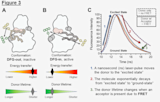Time-Resolved FRET

The use of a time component with Forster Resonance Energy Transfer (TR-FRET) allows for dynamic structural observations.
January 12th, 2025
I believe drugs are fascinating and incredibly powerful. Among hundreds of other uses, they can alleviate pain, stop diarrhea, alter your state of mind, and treat cancer. My interest in how drugs affect the body began at a young age, and for the past decade, I have been dedicated to conducting drug-related research.
“Structure determines function.” A simple phrase that describes a central biological concept. In deference to this mantra, the overarching goal of my research career is to dissect how structural movements of proteins modulate function, and to apply this understanding to improving therapeutics for treatment of human disease. My unique background, which combines industrial training in protein purification and molecular biology with graduate training in innovative biophysical techniques, has given me the tools necessary to understand proteins as living, “breathing” molecules, with dynamic structural movements that drive their function.

Structural biophysics with protein kinases in the Levinson Laboratory
I completed my graduate studies in the Levinson Laboratory, where I used biophysics to study allosteric mechanisms that regulate protein kinases, which are key signaling enzymes. Our broad goal was to understand how the protein "moves", which can lead to improved therapeutics. We aimed to develop strategies to quantify the relationships between conformational dynamics and drug selectivity in protein kinases.
A core hypothesis of the Levinson Lab is that the selectivity of kinase inhibitors is due to differences in the conformational dynamics ("movement") of each protein kinase. By discovering the relationship between these dynamics and inhibitor binding, we hope to guide future drug development efforts that exploit conformational dynamics to achieve better selectivity.

Molecular Imaging and Targeted Therapeutics in the LeBeau Laboratory
As acting lab manager, I started the lab at the University of Wisconsin, Madison for Dr. LeBeau. UW Madison, a leader in nuclear imaging technology, provided extensive support facilities crucial for our research. In addition to my lab manager duties, I used bio-panning, a directed-evolution methodology, to create novel nano- and antibodies targeting proteins involved in prostate cancer and other diseases. These antibodies have potential as both diagnostic and therapeutic options for advanced stages of prostate cancer.
Moreover, I helped to pioneer the use of Nurse sharks for the creation of biased nanobody libraries, managing their care, feeding, and procedures at a campus facility. I also purified one of LeBeau's key target proteins, Fibroblast Activating Protein (FAP), to identify binding locations for our in-development nanobodies derived from Nurse sharks. This investigation utilized cryo-EM techniques in collaboration with a graduate student in Dr. Tim Grant's lab.